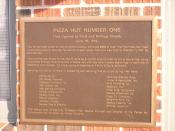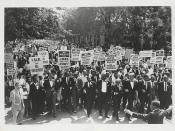SUMMARY & COMMENTS
This case presents the PepsiCo Company's situation between 1950s to early 1990s. PepsiCo is a large organization with a decentralized management approach.
In 1933, 12 ounces of Pepsi was equal to a nickel where for one nickel you could buy 6 ounces of Coca Cola. By the end of 1940s, when Alfred Steele was the CEO, the company moved from low price strategy and launched an extensive marketing campaign to boost the company's image. The strategy was successful. Sales increased to $14.2 million in 1960 from a postwar low of $1.3 million in 1950.
In 1963, Donald M.Kendall (CEO) and Andrall E.Pearson (COO) changed the company's cultural emphasis from passivity to aggressivity. During that time, the corporate office set strategy and maintained financial control, but left operating decisions to its energetic and industrious division managers who were eager to take charge. Kendall merged Pepsi-Cola with Frito Lay in 1965 and company name became PepsiCo.
Kendall's successor, Wayne Calloway (1986), put the emphasis more on his employees. When asked by a Fortune magazine reporter to what he attributed PepsiCo's outstanding performance during his tenure, he replied "the three P's 'people, people, people'". He also believed that different experiences made great managers. He also challenged his managers to be innovative and was known for saying, "If it ain't broke, fix it anyway". All those statements made by Colloway shows his strategy in management. He believes given the right environment and empowered in a correct way, the success will come and the success of the manager would be for sure the success of the company.
PepsiCo's Businesses
PepsiCo had three segments as shown in Table 1
Table 1
Soft Drinks Snack Foods Restaurants
1991 Sales/Total Sales 35% 29% 36%
1991 Profits/Total Profits 39% 35% 26%
In 1986, PepsiCo purchased KFC. Combined with Pizza Hut and Taco Bell, the purchase made PepsiCo the international leader in number of restaurant units.
In late 1980s, Coca Cola campaign against PepsiCo stating that restaurants that bought syrup from Pepsi-Cola were albeit indirectly, helping one of their toughest restaurant competitors. The result of this campaign cost PepsiCo to lose its Burger King and Wendy's accounts in 1991.
All three of PepsiCo's restaurant chains were considered quick service.
Pizza Hut
PepsiCo purchased Pizza Hut in 1977. In 1984, Pizza Hut challenged by Domino's Pizza chain focusing on delivery. As a result, Pizza Hut launched its own delivery business in 1985. In 1988, delivery business accounted for more than one quarter of Pizza Hut's sales growth and half of its profit growth at the store level. Delivery service was the first step toward repositioning of Pizza Hut into pizza distribution. Also expansion into non-traditional loacations like airports, amusement parks, stadiums and school lunch rooms was a key factor in its success.
In 1991, Pizza Hut offered two new concepts: quick service and casual dining. Competitors were doing either delivery, carryout or dine in. Pizza Hut were doing all!
Taco Bell
PepsiCo bought Taco Bell in 1978. It was country's largest chain of quick service Mexican restaurant. John Martin, CEO in 1983, added new products (product development) like Mexican Pizza, soft shell tacos and fajitas. He also remodeled restaurants.
Next, he launched a full scale effort to turn Taco Bell from a low-tech, labor intensive operation into a fast food retailer. The change in concept involved a shift in focus-from production to service. Becoming a food retailer, kitchen size in a restaurant decreased from 70% to 30%, allowing more seating and employees were able to spend more of their time with customers (customer focus).
Martin also empowered employees to make decisions. My personal opinion is that empowering the employees has been a key success factor not just in Taco Bell but in all PepsiCo companies. PepsiCo was able to make this a part of their company culture.
Early 1990s, Martin set out to reach airports, stadiums, retail stores, colleges and other nontraditional settings with carts, kiosks. Taco Bell also penetrated in to the casual dining segment by purchasing The Salsa Rio Grill & Salsa Bar.
KFC
When PepsiCo purchased KFC in 1986, KFC had a strong international business and was, by far, the largest chicken chain in the world. Under John Cranor's management, the company did structural changes like renovation program, a new computer system, restructuring its U.S. and international operations. KFC had faced some problems with its franchisees. Franchisees were concerned that KFC's increase in points of distribution might negatively impact traditional business. In 1989, the company rewrote the contract for those units coming up for renewal. The new contract replaced territorial exclusivity with site-specific arrangements.
Coordination across the Restaurants
The restaurants operated as stand-alone businesses, consistent with PepsiCo's decentralized structure and emphasis the firm placed on entrepreneurial management. There are no structural bonds but cultural bonds between the different units. The units share the ideas in natural way. Formal inquiries and exchange of ideas were often unnecessary as the executives in high and middle-level management often had recent experience in more than on of PepsiCo restaurants. The synergy is the key factor here.
PepsiCo Food Systems
PFS is a very good example of backward (supply) and forward (distribution) vertical integration. PFS generated cost savings of ten million dollars in its first year of operation and increasingly more thereafter. The case for the supply unit was not as good as distribution. The chains had different purchasing criteria for even the most general goods, and coordination was not assigned the same priority by all the chains. By 1992 PFS purchased 95% of the restaurants' line items, but less than 20% of total product costs. The individual chains were reluctant to relinquish control over the purchase of their 20-30 key items. For example, KFC purchased all its own chicken. Moreover, in 1980, about 3000 KFC franchisees established KFC National Purchasing Cooperative Inc. In early 1992, a Taco Bell franchisee cooperative joined with its KFC counterpart.
Pepsi Partners
Pepsi restaurants formed a common task force known as Pepsi Partners. The idea was to coordinate sales to large common customers. The advantage for the customer was to have a single point contact with PepsiCo. However, PepsiCo can not guarantee 3 restaurants availability for a given concession due to pre-existing franchise contracts.
Broad Based Coordination
There were 4 views on coordination:
External Consultant View: Restaurants can save about $100 million/year with extensive coordination on purchase & headquarter related tasks
Taco Bell CEO : believed in savings > $100 million with agressive drive out of duplicate costs.
Other restaurant CEOs not convinced: how to quantify the negative consequences on competetiveness? Ability to react fast ? Tailor resources to individual needs?
Corporate executives: Initiation should come from divisions, not headquarters. (autonom approach).
Development in the Early 1990s
Carts of Colorado
Taco Bell CEO, John Martin, believed in integration & mobile food bizz. For that reason, Taco Bell CEO interested in purchasing COC, early '90s. COC is a designer, manufacturer, merchandiser of mobile food carts & kiosks. COC sales' 20% was to PepsiCO in 1990. This was a mistake of Martin as the other COC customers were Burger King, Coca-Cola Company, Dunkin' Donuts, Mrs. Fields . They stopped buying from COC after the purchase. This is a similar situation as the Coca-Cola's campaign against Pepsi in late 1980s.
California Pizza Kitchen
Ken Stevens (Sr VP Strategic Planning) identified CPK as potential acquisition. For PepsiCo it was an entry to casual dining segment. CPK's unique selling power was its product features which are innovative Pizza and individual size. The target customer segment was moderate price, comparable quality, young, upscale singles and couples, families, elderly retired people. CPK was an alternative to fine dining restaurants.
As a conclusion the following hypotheses can be made about this case;
Manufacturing is not a relevant differentiation for a food/drink company like PepsiCo. Acquisition of COC was a mistake.
Even in a decentralized structure, coordination to some extend is vital. There should be a balance between the decentralization and the coordination.
As it can be seen in the case, employee empowerment is a key success factor. PepsiCo applied that as a company culture in a very efficient way which led to success in many cases.



Pepsico Restaurants
The overall content is pretty good. Weak intro / summary. I didn't find out the point behind the paper until I read the conclusion, which should have been a little more involved. With a proper intro and conclusion, it would make a very good college level essay.
4 out of 5 people found this comment useful.